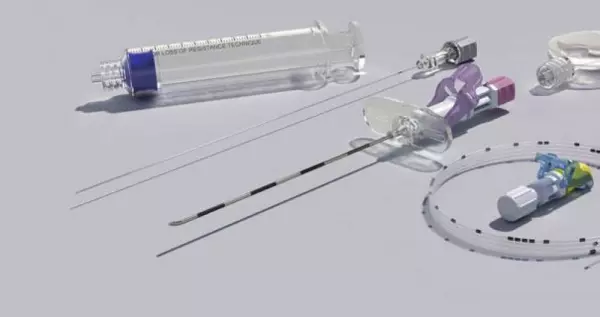
Unique CSE Needle System with Locking Mechanism, Back-eye Tuohy and SPROTTE® needle. The EpiS...
Portal and digital medical technology fair of the largest MedTech cluster in Germany

Atraumatic spinal anesthesia is performed by using needles with small gauge. A rounded-edge conical-point tip called a Sprotte needle was developed in the 1970s. Its specialized design minimizes the possibility of injury and prevents foreign bodies from entering the subarachnoid space. Additionally, it has been shown to reduce the incidence of post-dural puncture headache. Although there are still no reliable data on the effectiveness of atraumatic spinal anesthesia, this method is widely used.
The first atraumatic spinal anesthetic was performed by Karl August Bier in 1898. It was his first attempt to provide pain relief to his patient and he suffered from a disabling headache. Afterwards, Bier determined that the headache was due to an excessive loss of cerebrospinal fluid. The technique has improved over the past century, and today, it is the standard of care for diagnostic lumbar puncture.
The atraumatic technique was first introduced in the mid-nineteenth century. Its development was based on observations from Chinese physicians who advocated the use of needles in the treatment of pain. The concept of atraumatic anesthesia was first used in ancient Egypt and is a part of traditional Chinese medicine. A study published by August Bier and Bainbridge in the late nineteenth century led to a significant change in clinical anesthesia for infants and young children.
Among adults and older adolescents, infants and children have distinct anatomic differences. These differences are discussed in other chapters, but the use of CT-guided mechanisms and imaging techniques have helped to reduce the risk of complications. In addition, the epidural space in infants is more superficial than that of an adult, requiring greater skill and accuracy. In contrast, in children and older adolescents, the epidural space is deeper and requires more skill than in adults. A successful block is defined by positive dural click, a timed sequence of three CSF drops, and a short recovery period after surgery.
Patients with atraumatic anesthesia should be evaluated carefully before they undergo the procedure. ASA patients with unsuitable anatomy should be excluded from the study. For example, outpatient procedures should not be performed. In these cases, atraumatic anesthesia is the best option for the patient and the surgeon. This type of anesthesia is a safer and more effective alternative. It is used to treat atraumatic spine disorders.
Atraumatic spinal anesthesia is a safe and effective option for patients undergoing surgery. However, patients who are sensitive to invasive surgery should avoid this treatment. It can result in a lower blood pressure and cause permanent paralysis. The duration of the procedure also affects the quality of life of the patient. It is important to have the procedure performed by a physician who is familiar with the procedure. There are no known adverse effects of atraumatic spinal anesthesia.
Become a digital exhibitor yourself in the online portal of the largest and best-known MedTech cluster region in Germany and inform the world of medical technology about your products and services as well as about news, events and career opportunities.
With an attractive online profile, we will help you to present yourself professionally on our portal as well as on Google and on social media.